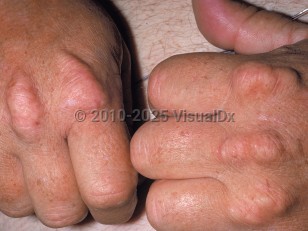Xanthoma tendinosum
Alerts and Notices
Important News & Links
Synopsis

Tendinous xanthomas (xanthoma tendinosum) are lipid deposits within tendons that almost always indicate an underlying disorder of lipid metabolism. They typically appear as smooth, firm nodules over extensor tendons of the elbows, knees, hands, or classically, the Achilles tendon.
The underlying lipid disorder may be familial hypercholesterolemia (FH), familial defective apolipoprotein B-100, familial dysbetalipoproteinemia (FD), myxedema, or hepatic cholestasis. The most common cause of tendinous xanthoma is FH, and involvement of the Achilles tendon is specific for FH. Tendinous xanthomas are present in approximately 30%-50% of those with FH. They most commonly occur in patients who are heterogenous for FH. While homogenous FH patients have higher LDL levels, which should predispose them to tendinous xanthoma at a higher rate, they often succumb to complications of atherosclerosis before developing tendinous xanthomas.
Rarely, patients can develop tendinous xanthomas in the absence of a lipoprotein disorder, such as in the cases of β-sitosterolemia and cerebrotendinous xanthomatosis (CX). The substance of deposition in β-sitosterolemia is plant sterol, and in the case of CX, it is an intermediate from the bile acid synthesis pathway called cholestanol, which gets deposited in almost all tissues in patients with CX.
Patients with CX will present with intellectual disability, cataracts, and/or neurologic symptoms and require prompt therapy to prevent irreversible neurologic damage. The genetic defect responsible for CX is an autosomal recessive mutation in the sterol 27-hydroxylase gene.
Pediatric Patient Considerations: Tendinous xanthomas are not seen in children unless the rare form of homozygous FH is present in the patient or the patient has CX. In either case, a child with tendinous xanthomas requires prompt evaluation and medical treatment to prevent irreversible disease sequelae.
The underlying lipid disorder may be familial hypercholesterolemia (FH), familial defective apolipoprotein B-100, familial dysbetalipoproteinemia (FD), myxedema, or hepatic cholestasis. The most common cause of tendinous xanthoma is FH, and involvement of the Achilles tendon is specific for FH. Tendinous xanthomas are present in approximately 30%-50% of those with FH. They most commonly occur in patients who are heterogenous for FH. While homogenous FH patients have higher LDL levels, which should predispose them to tendinous xanthoma at a higher rate, they often succumb to complications of atherosclerosis before developing tendinous xanthomas.
Rarely, patients can develop tendinous xanthomas in the absence of a lipoprotein disorder, such as in the cases of β-sitosterolemia and cerebrotendinous xanthomatosis (CX). The substance of deposition in β-sitosterolemia is plant sterol, and in the case of CX, it is an intermediate from the bile acid synthesis pathway called cholestanol, which gets deposited in almost all tissues in patients with CX.
Patients with CX will present with intellectual disability, cataracts, and/or neurologic symptoms and require prompt therapy to prevent irreversible neurologic damage. The genetic defect responsible for CX is an autosomal recessive mutation in the sterol 27-hydroxylase gene.
Pediatric Patient Considerations: Tendinous xanthomas are not seen in children unless the rare form of homozygous FH is present in the patient or the patient has CX. In either case, a child with tendinous xanthomas requires prompt evaluation and medical treatment to prevent irreversible disease sequelae.
Codes
ICD10CM:
E75.5 – Other lipid storage disorders
SNOMEDCT:
69880002 – Xanthoma tendinosum
E75.5 – Other lipid storage disorders
SNOMEDCT:
69880002 – Xanthoma tendinosum
Look For
Subscription Required
Diagnostic Pearls
Subscription Required
Differential Diagnosis & Pitfalls

To perform a comparison, select diagnoses from the classic differential
Subscription Required
Best Tests
Subscription Required
Management Pearls
Subscription Required
Therapy
Subscription Required
References
Subscription Required
Last Reviewed:06/27/2022
Last Updated:06/28/2022
Last Updated:06/28/2022
Xanthoma tendinosum

